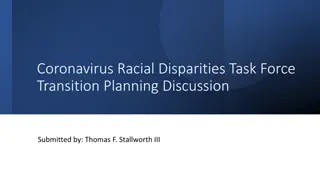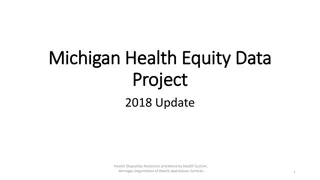Understanding Racial and Ethnic Income Disparities
This piece delves into the income and wealth gaps among different racial and ethnic groups, emphasizing the importance of framing when analyzing such disparities. It presents data from the Federal Reserve's Survey of Consumer Finances, highlighting the slower closure of income gaps for Black and Hispanic families compared to Non-Hispanic White families. Furthermore, it showcases how racial/ethnic wealth disparities are significantly wider than income gaps, with Black and Hispanic families facing substantial wealth discrepancies. The article underscores the role of factors like education, demographics, and systemic influences in shaping these disparities.
Uploaded on Oct 06, 2024 | 0 Views
Download Presentation

Please find below an Image/Link to download the presentation.
The content on the website is provided AS IS for your information and personal use only. It may not be sold, licensed, or shared on other websites without obtaining consent from the author. Download presentation by click this link. If you encounter any issues during the download, it is possible that the publisher has removed the file from their server.
E N D
Presentation Transcript
Interpreting Racial and Ethnic Income and Wealth Gaps: Framing Matters William R. Emmons* Federal Reserve Bank of St. Louis March 28, 2019 *In collaboration with Ana H. Kent and Lowell R. Ricketts. The views expressed here do not necessarily reflect those of the Federal Reserve Bank of St. Louis or the Federal Reserve System.
Interpreting Racial and Ethnic Income and Wealth Gaps: Framing Matters Income and wealth data from the Federal Reserve s Survey of Consumer Finances The importance of framing The post-racial model of income and wealth A model that allows structural, systemic and other unobservable factors to matter Application: Does higher ed level the playing field? 1
The Demographics of Wealth Series 2018 Series HFS essay series links income, wealth and other socio-economic outcomes to a family s: Race/ethnicity Education (own and parents ) Age and birth year. 2015 Series Your race/ethnicity, education and birth year are strong predictors of your adult outcomes. www.stlouisfed.org/household-financial-stability/ 2
Black & Hispanic Income Gaps Closing Slowly Data from the Federal Reserve s Survey of Consumer Finances. Median Real Income, Relative to Non-Hispanic White Families Percent 140 120 Typical (median) income of black and Hispanic families has moved closer to that of white families but remains 40% lower. White level 100 80 60 40 20 The typical other-race family (mostly Asian) has surpassed the typical white family s income. 0 1989 1992 1995 1998 2001 Survey Year 2004 2007 2010 2013 2016 Black Hispanic, Any Race Other Races Source: Federal Reserve Board's Survey of Consumer Finances. 3
Racial/Ethnic Wealth Gaps Larger than Income Median Household Net Worth, by Race/Ethnicity of Respondent, 2016 Thousands of 2016 $ Black-white median wealth gap in 2016: -90% Racial/ethnic wealth gaps in 2016 vis- -vis the median/typical white family are much wider than income gaps 180 163 160 140 120 100 100 80 Black families (-90%) 60 Hispanic families (-87%) 40 22 16 20 Other families (-39%) 0 Black Hispanic, Any Race Other Races White, Non- Hispanic Source: Federal Reserve Board's Survey of Consumer Finances. Note: "Other Races" includes Asians, Native Alaskans, Pacific Islanders, Native Americans, and families identifying with more than one race or ethnicity. 4
Racial/Ethnic Wealth Gaps Very Persistent White level 100 Median Real Net Worth, Relative to Non-Hispanic White Families Percent Relative wealth of typical black and Hispanic families has improved a bit since 1989, but the gaps remain close to 90 percent. 80 70 60 50 40 30 Other nonwhite families wealth remains below typical white family s, despite higher income. 20 10 0 1989 1992 1995 1998 2001 Survey Year 2004 2007 2010 2013 2016 Black Hispanic, Any Race Other Races Source: Federal Reserve Board's Survey of Consumer Finances. 5
Two Ways to Interpret Large, Persistent Racial and Ethnic Income and Wealth Gaps The standard post-racial model: Assume that every family faces the same opportunities and choices. Poor wealth outcomes therefore reflect poor choices. A model that allows structural, systemic or other unobservable factors : Assume that peer groups and context may be just as important as individual choices. Poor wealth outcomes may reflect poor opportunities. 6
Application: Does Higher Ed Close Wealth Gaps? Analyze racial and ethnic wealth groups using Model 1. Reference group is families of white 2- or 4-year college grads. Control for differences in age, education, family structure, financial/balance-sheet characteristics, health, inheritances. How much of the racial/ethnic wealth gap remains unexplained ? 7
1) If Everyone Copied White College Grads, What Would the Racial Wealth Gaps Be? Predicted Wealth by Education Level and Race, Full Post-Racial Model Index = Per $100 of College-Educated White Family's Wealth The post-racial model is standard in economics. $200 White Other Hispanic Black $180 Assumes everyone can/should mimic the financial, familial, health and inheritance patterns of the reference group. $160 151 141 $140 Reference group $120 111 110 100 $100 85 81 79 73 72 $80 68 59 59 54 51 $60 42 $40 If race doesn t matter, predicted wealth is same for all groups within an education level; RWG=0. $20 $0 No High School Diploma High School Diploma/GED Diploma Two- or Four-year College Degree Post Graduate Degree Source:Federal Reserve Board's Survey of Consumer Finances and author's calculations. 8
1) If Everyone Copied White College Grads, What Would the Racial Wealth Gaps Be? Predicted Wealth by Education Level and Race, Full Post-Racial Model Index = Per $100 of College-Educated White Family's Wealth Yes, gaps are lower after controlling for different choices (financial, familial). Average black-white wealth gaps in all survey years, by education $200 -40% White Other Hispanic Black $180 -21% $160 151 141 But racial and ethnic wealth gaps are not zero. $140 Reference group -19% $120 111 110 100 $100 -22% 85 81 79 The residual race effects are largest among blacks. 73 72 $80 68 59 59 54 51 $60 42 $40 The residual race/ethnicity effects are largest among post-graduate degree holders. $20 $0 No High School Diploma High School Diploma/GED Diploma Two- or Four-year College Degree Post Graduate Degree Source:Federal Reserve Board's Survey of Consumer Finances and author's calculations. 9
Application: Does Higher Ed Close Wealth Gaps? Analyze racial and ethnic wealth groups using Model 2. Reference groups are white families of a given education level. Calculate age/race-specific means for all control variables. Define individual choices as difference between actual level and own peer group s average level in each year. How much of the racial/ethnic wealth gap remains unexplained ? These numbers are estimates of the structural/systemic/ unobservable wealth gaps due to race or ethnicity. 10
2) What If Your Agency Is Defined as Differences from Group Averages or Norms? Predicted Wealth by Education Level and Race, Full Structural Model Index = Per $100 of College-Educated White Family's Wealth This is a model in which structural, systemic and other unobservable factors related to race or ethnicity are assumed to define where individual agency begins. $120 Reference groups White Other Hispanic Black 106 100 100 100 100 $100 88 $80 73 70 $60 36 $40 33 29 29 28 26 26 Compare within ed levels. 24 $20 Model isolates maximum gap that could be due to race-related factors. $0 No High School Diploma High School Diploma/GED Diploma Two- or Four-year College Degree Post Graduate Degree Source:Federal Reserve Board's Survey of Consumer Finances and author's calculations. 11
2) What If Your Agency Is Defined as Differences from Group Averages or Norms? Predicted Wealth by Education Level and Race, Full Structural Model Index = Per $100 of College-Educated White Family's Wealth Average black-white wealth gaps in all survey years are very similar across education levels. $120 Reference groups White Other Hispanic Black 106 100 100 100 100 $100 88 $80 73 70 -71% -72% -76% -74% Black-white gaps generally are the largest. $60 36 $40 33 Conclusion: Vast majority of the raw (-90%) wealth gap is due to between- group rather than within- group differences. 29 29 28 26 26 24 $20 $0 No High School Diploma High School Diploma/GED Diploma Two- or Four-year College Degree Post Graduate Degree Source:Federal Reserve Board's Survey of Consumer Finances and author's calculations. 12
Summary of Interpreting Racial and Ethnic Income and Wealth Gaps: Framing Matters Racial and ethnic income and especially wealth gaps are very large and very persistent. How we interpret the gaps depends on framing. The standard post-racial model of income and wealth blames poor choices. A model that includes structural, systemic and other unobservable factors points to poor opportunities. Higher ed cannot overcome vastly different starting points. 13
References Does College Level the Playing Field? Racial and Ethnic Differences in Family Wealth Among College-Educated Families. A Research Symposium. May 25-25, 2016. Link. Emmons, William R.; and Noeth, Bryan J. Race, Ethnicity and Wealth. The Demographics of Wealth, February 2015, Essay 1, Link. Emmons, William R.; and Ricketts, Lowell R. College Is Not Enough: Higher Education Does Not Eliminate Racial and Ethnic Wealth Gaps. Federal Reserve Bank of St. Louis Review, First Quarter 2017, Vol. 99, No. 1, pp. 7-39. Link. Emmons, William R.; and Ricketts, Lowell R. College Inadvertently Increases Racial and Ethnic Disparity in Income and Wealth. In the Balance, February 2017, Issue 16. Link. Emmons, William R.; Kent, Ana H.; and Ricketts, Lowell R. The Financial Returns from College across Generations: Large but Unequal. The Demographics of Wealth 2018 Series, February 2018, Essay 1, Link. 14
Connect With Us STLOUISFED.ORG/HFS Newsletter 15























